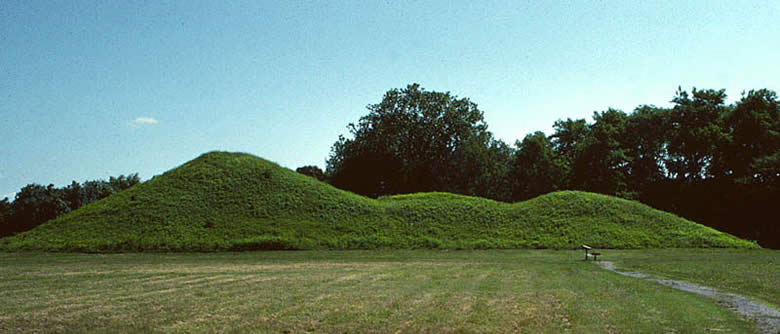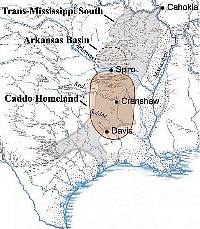
Spiro and the Arkansas Basin in relationship
to the main Caddo Homeland and the Trans-Mississippi
South biographical zone. Base map by Erwin Raisz. Click
on image for enlarged view.
|
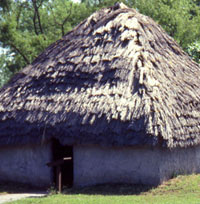
Reconstruction of a large rectangular
house at Spiro. This reconstruction is on display at
the site, now an Oklahoma state park. Photo by Dee Ann
Story.
|
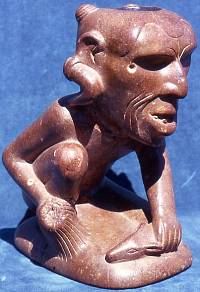
This unique human effigy pipe, depicts a naked man with
a larger-than-life head holding the head of a deer to
the ground in his left hand and a fringed object in
his right hand.
The pipe is made of red flint clay from a source near
St. Louis, Missouri not far from the great Mississippian
center of Cahokia. Thomas Emerson and colleagues believe
this pipe may be a hierloom item that was originally
made for use at Cahokia. Their hypothesis is that this
and similar ritual items left Cahokia in the late 13th
century as the center's power waned to be reused at
ascending centers like Spiro. Height 23 centimeters
(9 inches). Courtesy Robert Bell and the Sam Noble Oklahoma
Museum of Natural History, University of Oklahoma. |
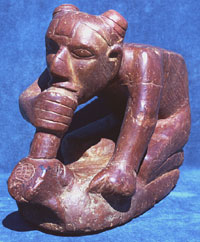
Effigy pipe of male figure crouching
and smoking what appears to be (upon close inspection)
to be a frog effigy pipe. Made of red flint clay from
near Cahokia. The pipe is 20.5 centimeters high and
36.5 centimeters long. Click to enlarge and see back
of pipe. Courtesy Robert Bell and the Sam Noble Oklahoma
Museum of Natural History, University of Oklahoma.
|
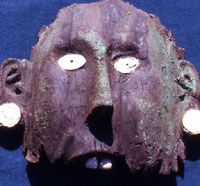
Wooden mask with marine shell inlays
from Craig Mound, Spiro. The mask was carved from red
cedar and apparently was once covered with sheet copper.
Courtesy Robert Bell and the Sam Noble Oklahoma Museum
of Natural History, University of Oklahoma.
|
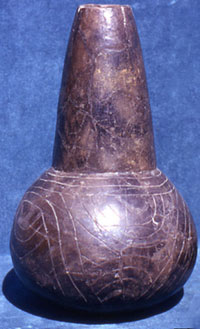
Spiro Engraved bottle and Crockett
Curvilinear-Incised bowl from Craig Mound, Spiro. Both
vessels are almost certainly Caddo vessels, probably
obtained from Red River Valley. Courtesy Robert Bell
and the Sam Noble Oklahoma Museum of Natural History, University of Oklahoma.
|
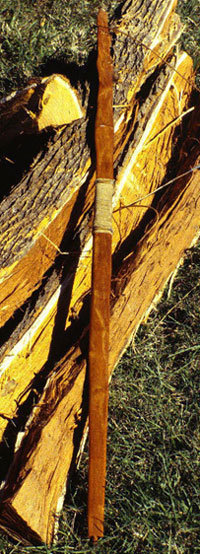
Bois d'arc (Osage orange) wood, one
of the best bow-making woods in North America, was traded
far and wide from its only source, a small area of the
Caddo Homeland near the Red River above the Great Bend.
Photo by Frank Schambach.
|
|
Spiro's wealth is almost certainly a consequence
of its strategic position as a "gateway" community
and trading center between the Mississippian world to
the east and the Great Plains to the west.
|
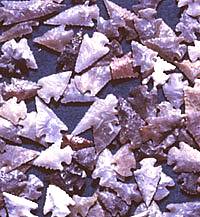
Caches of arrow points were common
offerings in Craig Mound. These are Agee points made
of novaculite and other materials. Courtesy Robert Bell
and the Sam Noble Oklahoma Museum of Natural History, University of Oklahoma.
|
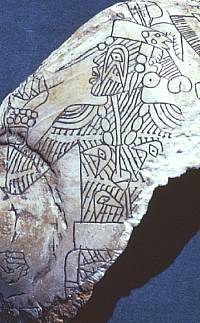
Engraved image of tatooed man on
marine shell cup from Craig Mound. Courtesy Robert Bell
and the Sam Noble Oklahoma Museum of Natural History, University of Oklahoma.
|
|
Just to the north of the main Caddo Homeland
lies the mound center of Spiro in the Arkansas River
valley in extreme eastern Oklahoma. Spiro was the westernmost
of the primate (main) centers in the Mississippian world during
the 12th through mid-15th centuries (A.D. 1100-1450). Spiro
was certainly not anywhere near as large or powerful as Cahokia,
the largest town and political capital in prehistoric America
north of Mexico. But Spiro is famous for the unprecedented
amount of wealth that was accumulated by its leaders and buried
with them.
In 1933, local entrepreneurs formed the "Pocola
Mining Company" to loot Craig Mound, the site's
largest mound. Craig Mound was actually four connected mounds,
a large cone-shaped one and three smaller ones. Digging by
hand with no real idea of what they were digging into, the
looters made relatively slow progress for the first year.
They did encountered many graves and offerings in the smaller
mounds and these began to appear on the market. This eventually
provoked a public outcry and Oklahoma passed one of the first
state laws protecting antiquities in 1935. Unfortunately,
the looters were able to continue digging secretly and finally
struck upon an effective way of getting what they wanted:
they hired coal miners to tunnel into the largest cone.
The main tunnel into the center of the mound
encountered a gaping hollow, the shell of a purposefully buried
mortuary building. Inside were elaborate special burials and
jumbled human bones accompanied by unbelievable quantities
of unusual artifacts made of marine shell, exotic stone, bone,
copper, feathers, fabrics, fur, and all manner of materials.
Many of these items represent ritual paraphernalia linked
to the Southern Cult (Southeastern Ceremonial Complex).
As their lease expired and as state authorities
moved to shut down the operation, the Pocola miners tried
to blow up the rest of the mound in a fit of pique. Although
they failed, the damage they had already wrought is one of
the greatest tragedies in American archeology. The whole and
partial artifacts were quickly sold off and wound up in dozens
of museums and private collections around the country. The
1936-1941 WPA archeological excavations by the University
of Oklahoma salvaged many pieces and much information. More
recent work at the site and thorough analyses of the spectacular
collections have made Spiro one of the most important archeological
sites in North America.
Spiro was not an isolated place, but was instead
at the top of a hierarchy of settlements within the Arkansas
Basin—west and north up the Arkansas River and its
tributaries draining the southwestern Ozark Plateau and adjacent
tall-prairies to the west. Related sites are said to occur
within the White River drainage in southernmost Missouri.
During the Harlan phase (A.D. 1000-1250), Spiro was
a ceremonial and population center. After A.D. 1250, the residential
population moved to other sites in the area and Spiro was
used only as ceremonial and mortuary center. The site's role
as a mortuary center peaked in the Norman and Spiro
phases (A.D. 1250-1350 and 1350-1450, respectively). After
A.D. 1450, the site ceased to play an important role in the
region, possibly because east-west trade routes shifted southward
through the Red River valley.
Spiro's wealth is almost certainly a consequence
of its strategic position as a gateway community and
trading center between the Mississippian world to the east
and the Great Plains to the west. Spiro is thought to have
served in much the same way as did St Louis, Missouri in the
18th and 19th centuries: as a crucial hub through which most
east-west commerce and traffic had to pass. In Spiro's case,
the nature and substance of the trade is debated. Some argue
that Spiro was at the center of a trade system that moved
relatively large quantities of economically useful materials
including food, clothing, and weapons. In contrast, other
scholars think that Spiro trade amounted mainly to exchanges
between leaders of ritual items related to the Southern Cult.
The view here is that Spiro trade almost certainly had both
economic and ritual importance.
At Spiro, most of the exotic materials
come either from the local region (including the main Caddo
Homeland to the south) or from distant sources far to the
east. Among the distant sources are those in the Midwest around
Cahokia and across the Southeast, including the Appalachian
Mountains (Tennessee-Kentucky area) and the northeastern Gulf
coast (Florida-Mississippi). It is somewhat less clear what
was moving from the opposite direction from the Great Plains
that would attract this great wealth from the Eastern Woodlands.
Grave145 in Craig Mound had strings of shell beads that had
a total of almost 14,000 beads made from dwarf olive shells
from the Gulf of California. Some of the garments found at
Spiro are made of bison hair, jack rabbit fur, and cotton
fiber. These hint that most of what was moving west-to-east
may have been of perishable material.
Frank Schambach argues that dried bison meat
and bison hides were the principal items moving east from
the Plains. Further, he believes that Spiro also controlled
the trade in bois d'arc wood and finished bows obtained from
the Red River valley in the core of the Caddo Homeland. Bows
and bow wood would have been highly desirable to both the
bison hunters on the Plains as well as the warriors and hunters
of the Mississippian world to the east.
This brings us back to the question of who the
Spiroans were and how they relate to the Caddo groups along
the Red River and elsewhere in the main Caddo Homeland. Although
Spiro and its Arkansas Basin hinterland has long been known
to archeologists as the "Northern Caddoan Area,"
the ethnic/linguistic identity of the Spiroans is debated.
The four possibilities that have been advanced include: the
ancestors of the Caddo, Kitsai, Wichita, and Tunica.
The main reason the debate lingers is because
of the break in the cultural sequence of the Arkansas Basin.
Following the demise of Spiro as an important center by A.D.
1450, the succeeding Ft. Coffee phase (A.D. 1450-1650?)
is said to evidence some cultural continuity with Spiro's
heyday but also changes, such as a shift to circular houses
(from rectangular). Other changes, such as the use of underground
storage pits, are said to reflect a western orientation toward
the Plains. While most authorities think the main east-west
trade routes shifted south through the central part of the
Caddo Homeland, Schambach argues the Spiro area still served
as a gateway community after the demise of the site as a major
center.
By the time French traders entered that part
of the Arkansas Valley in 1719, Spiro was long abandoned and
the area was essentially unoccupied. Farther up the Arkansas
River the French found villages and camps of Wichita and Kitsai
groups, both speakers of Northern Caddoan languages. Yet,
the lifestyle of these peoples as observed by the French was
very different from that of the Spiroans. Were these Northern
Caddoan peoples the descendants of the Spiroans? And what
about the strange people of the province known as Tula that
the De Soto expedition encountered in 1542 somewhere along
the lower or middle Arkansas River?
Parallels between the Arkansas Basin and the
Caddo Homeland to the south have caused generations of archeologists
to believe that the two areas are part of the same "Caddoan"
cultural tradition. This interpretation was built partly
on the finding at Spiro of many finely engraved pots, particularly
of the style named Spiro Engraved, during the WPA excavations
there in 1936-1941. Since the engraved pots are clearly of
the Caddo ceramic tradition and it was assumed that they were
made at Spiro, then Spiro was seen as being part of the Caddo
tradition. But it is now recognized that many of these Caddo-like
pots at Spiro are indeed Caddo pots that come from the main
Caddo Homeland, not the Arkansas Basin. Spiro Engraved, for
instance, was almost certainly manufactured in the valley
of Red River. This realization has done little to alter the
notion that Spiro was part of the Caddo tradition.
The combined region and culture has been called,
variously, the Caddoan Area, the Caddoan Cultural Tradition,
and the Caddoan Mississippian culture based on the assumption
that the entire area was populated by the ancestors of Caddo-speaking
groups. But the obvious dissimilarities (including different
mortuary practices, different dominant house forms, and distinctive
skeletal characteristics) have led to uncertainty about this
all-Caddo notion. Despite many similarities, the Arkansas
Basin cultures were distinct from those in the main Caddo
Homeland for at least 600-800 years (roughly A.D. 800-1600).
Some archeologists believe the parallels between
the two adjacent areas are more important than the differences.
They point to the fact that within the main Caddo homeland
itself there is considerable diversity from local area to
local area. Archeologist Ann Early, who has worked extensively
in the Ouachita Mountains, sees many similarities between
Caddo sites in that area and those in the Arkansas Basin.
For instance, square and rectangular structures (often temples
or other special buildings) are common at Late Caddo sites
in the Ouachita Mountains. (Rectangular buildings are also
found widely farther south in east Texas, but they are vastly
outnumbered by circular structures.) Early and other archeologists
hypothesize that, after the demise of Spiro as a major population
and ritual center in the mid-15th century, the local (presumably
Caddo-speaking) people may have begun migrating south and
east into the nearby Ouachita Mountains.
Or perhaps, as some archeologists have argued,
the Spiroans were the ancestors of one of the tribes that
are closely linguistically related to the Caddo. The Kitsai
and Wichita have been singled out as the most likely
candidates, but not very convincingly so. If these groups
were the descendants of Arkansas Basin peoples, why were their
cultures so different in so many important ways from that
of Spiro? For instance, the Wichita were known throughout
historic times for their round, beehive-shaped grass houses
quite similar to those characteristic of the early historic
Caddo. Yet, Spiro houses were square or rectangular with four-
or two-post central roof supports and an extended entranceway,
a very different architectural tradition. Similarly, Wichita
pottery seems to have been part of the Plains tradition of
cord-marked utilitarian wares, not the engraved fine wares
of the Caddo tradition.
Oklahoma archeologists Charles Rohrbaugh and
Don Wyckoff think a better case may be made for the Kitsai.
They see parallels between the post-Spiro Fort Coffee phase
(ca. A.D. 1450-1600) in the Arkansas Valley and historic village
sites along the Grand River that have been linked to the Kitsai.
Unfortunately, so little is known for sure about the history
of the Kitsai that the Spiro-Kitsai hypothesis has yet to
be confirmed.
The most controversial (and intriguing) suggestion
is that the Spiroans were neither Caddo nor Caddoan, but the
ancestors of the Tunica tribe of the lower Mississippi
Valley. Frank Schambach's hypothesis is that the province
of Tula that De Soto's army attacked in 1542 was at
or near Spiro and that the Tulans were one and the same as
the archeologically known Spiroans. He argues that the descendants
of the Spiroans are the Tunica. From the late 1600s onward
the curious history of the Tunica is well known. The Tunica
were closely allied trading partners with the French and served
as middlemen through which guns and trade goods moved west
in exchange for horses, furs, and hides. They were unequivocally
identified first in the late 1600s on the lower Yazoo River,
just upstream from where the Arkansas meets the Mississippi.
From there they repeatedly moved their villages down the Mississippi
in response to epidemics and trading opportunities.
Schambach's full argument is too complex and
lengthy to be presented here. Basically, he thinks the Tunica
were far more than mere middlemen and were active long-distance
traders who operated a vast trading network during the 18th
century that linked the Southern Plains, the Caddo Homeland,
and the lower Mississippi. This network is said to represent
a continuation or evolution of the one established 600 years
earlier by the ancient Spiroans. Part of the evidence involves
a peculiar type of cranial deformation caused by binding the
heads of infants such that their heads became pointed. The
deformed heads of the people of Tula horrified the Spanish
in 1542. Archeologically this trait is said to be present
at Spiro and at the Sanders site on the Red River, which Schambach
argues was a subsidiary trading center linked to Spiro. It
has yet to be established that the Tunica had this particular
form of deformation, although one French account may suggest
that this was so. Schambach speculates that these grotesque
heads would have given the traders instant recognition, an
advantage when traveling through the territories of other
groups.
While the Tunica hypothesis is fascinating,
it based on a string of tentative inferences that may not
withstand rigorous analysis. Schambach's argument has
not won over the leading researchers who have worked in the
Arkansas Basin. They apparently reject the idea entirely,
but have yet to counter the argument forcefully in print.
The Tunica hypothesis is also rejected out of hand by the
Caddo and Wichita tribes; both tribes claim Spiro as part
of their ancestral realm.
And here is where we will leave the questions
of who the Spiroans were and whether the Arkansas Basin is
truly part of the Caddo Homeland. Unresolved. The view
here is that the problem is a fascinating and important one
worthy of additional research. Schambach's challenge to
the status quo is a very serious one that should be considered
carefully by Spiro scholars, not rejected out of hand. If
a better case can be made for the Kitsai (or the Wichita or
the Caddo), then it should be made with stronger arguments
and better data than has been presented so far. That said,
there may never be enough evidence of the sort needed to make
definitive links between the people who lived at Spiro 600
years ago and living peoples.
Two things are clear regarding the history of
the Caddo peoples. One is that the Arkansas Basin and the
main Caddo Homeland were home to substantially different groups
of people, whether they shared a common ancestry or not.
If the prehistoric peoples of the Arkansas Basin were Caddo-speakers
or speakers of one of the Northern Caddoan languages, they
split from the southern Caddo groups over 1200 years ago.
The other, equally important point is that the two areas
were linked through shared cultural elements and trade for
at least 800 years. There is little or no evidence of
conflict between the peoples of the two areas and much evidence
of trade and the exchange of ideas.
|
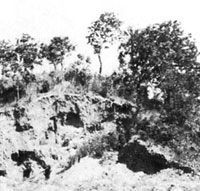
Craig Mound as it appeared in 1936
after the "Pocola miners" as the looters called
themselves, were through with it. The destruction of
much of this mound is one of the great tragedies of
American archeology.
Click images to enlarge
|
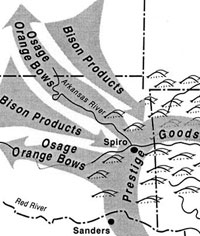
Spiroan trade network in Mississippian
times (about A.D. 1250-1450) as envisioned by Frank
Schambach. This interpretation shows bison products
moving from the Plains east to the Mississippi valley,
while prestige goods moved the opposite direction. Bows
made of Bois d'arc (Osage orange) from the Red River
valley near the Sanders site went both east and west.
Courtesy Frank Schambach.
|
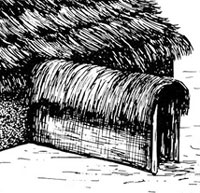
Artist's reconstruction of a large
house based on archeological remains uncovered at House
Mound #5 at Spiro. The grass-thatched roof is supported
by four interior posts. The walls are made of closely
spaced thin poles set within a foundation trench. Daub
(dried mud) plaster sealed the walls. The extended entranceway
helped keep heat from escaping in the winter. This very
large house (9-x-9 meters or 29-x-29 feet) is thought
to have been an elite residence, rather than an ordinary
dwelling. Courtesy Oklahoma Archaeological Society.
|
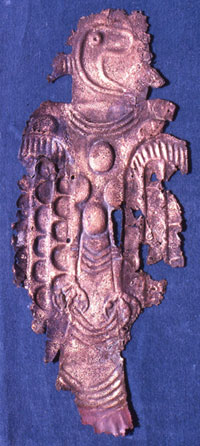
Embossed copper plate from Craig
Mound, Spiro. The bird figure, identified as a peregrine
falcon, has a distinctive "weeping eye" motif
that appears in many falcon depictions on religious
paraphernalia associated with the Southern Cult. Courtesy
Robert Bell and the Sam Noble Oklahoma Museum of Natural
History, University of Oklahoma.
|
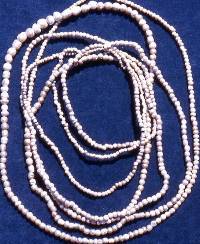
Necklaces of pearl beads from Craig
Mound, Spiro. The pearls were obtained from freshwater
mussels. Large numbers of pearl beads were found in
the mortuary contexts at Spiro. Commercial looters were
said to have amassed two gallons of pearl beads. Courtesy
Robert Bell and the Sam Noble Oklahoma Museum of Natural
History, University of Oklahoma.
|
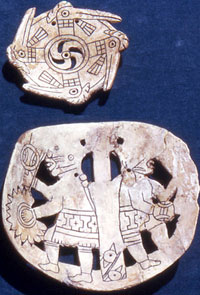
Marine shell gorgets from Craig Mound,
Spiro, probably made of conch (lightening whelk) from
the northern Gulf coast. These artifacts often bear
elaborate iconography associated with the Southern Cult.
Courtesy Robert Bell and the Sam Noble Oklahoma Museum
of Natural History, University of Oklahoma.
|
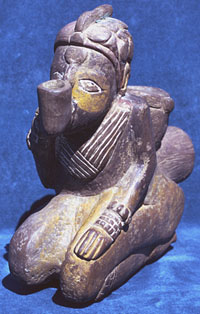
Pipe-smoker effigy pipe made of fine
sandstone, with added white and yellow mineral paint.
The distinctive hair style is identified by James Brown
as characteristic of the shell engraving found at Mississippian
sites in Southern Appalachian and Tennessee-Cumberland
areas. Height and length both about 22 centimeters.
Courtesy Robert Bell and the Sam Noble Oklahoma Museum
of Natural History, University of Oklahoma. Click to see enlargement and side
view.
|
|
The ethnic/linguistic identity of the Spiroans is
debated. Four possibilities have been advanced: the
ancestors of the Caddo, Wichita, Kitsai, and Tunica.
The problem remains unresolved.
|
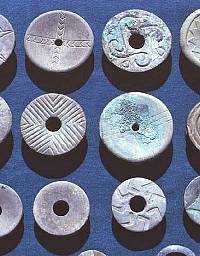
Stone earspools from Craig Mound.
Some were originally covered with sheet copper. Courtesy
Robert Bell and the Sam Noble Oklahoma Museum of Natural
History, University of Oklahoma..
|
|
